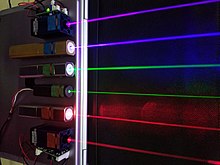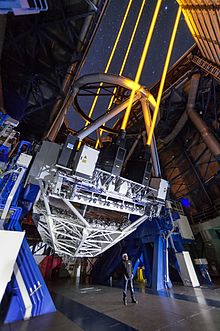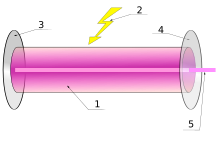What is Laser Technology?
A laser is a device that emits light through a process of optical amplification based on the stimulated emission of electromagnetic radiation. The word “laser” is an acronym for “light amplification by stimulated emission of radiation“. The first laser was built in 1960 by Theodore H. Maiman at Hughes Research Laboratories, based on theoretical work by Charles Hard Townes and Arthur Leonard Schawlow.

A laser beam used for welding
A laser differs from other sources of light in that it emits light which is coherent. Spatial coherence allows a laser to be focused to a tight spot, enabling applications such as laser cutting and lithography. Spatial coherence also allows a laser beam to stay narrow over great distances (collimation), enabling applications such as laser pointers and lidar. Lasers can also have high temporal coherence, which allows them to emit light with a very narrow spectrum. Alternatively, temporal coherence can be used to produce ultrashort pulses of light with a broad spectrum but durations as short as a femtosecond.
Lasers are used in optical disc drives, laser printers, barcode scanners, DNA sequencing instruments, fiber-optic, semiconducting chip manufacturing (photolithography), and free-space optical communication, laser surgery and skin treatments, cutting and welding materials, military and law enforcement devices for marking targets and measuring range and speed, and in laser lighting displays for entertainment. Semiconductor lasers in the blue to near-UV have also been used in place of light-emitting diodes (LED’s) to excite fluorescence as a white light source. This permits a much smaller emitting area due to the much greater radiance of a laser and avoids the droop suffered by LED’s; such devices are already used in some car headlamps.
Fundamentals
Modern telescopes use laser technologies to compensate for the blurring effect of the Earth’s atmosphere.
Lasers are distinguished from other light sources by their coherence. Spatial (or transverse) coherence is typically expressed through the output being a narrow beam, which is diffraction-limited. Laser beams can be focused to very tiny spots, achieving a very high irradiance, or they can have very low divergence in order to concentrate their power at a great distance. Temporal (or longitudinal) coherence implies a polarized wave at a single frequency, whose phase is correlated over a relatively great distance (the coherence length) along the beam. A beam produced by a thermal or other incoherent light source has an instantaneous amplitude and phase that vary randomly with respect to time and position, thus having a short coherence length.
Lasers are characterized according to their wavelength in a vacuum. Most “single wavelength” lasers actually produce radiation in several modes with slightly different wavelengths. Although temporal coherence implies some degree of monochromaticity, there are lasers that emit a broad spectrum of light or emit different wavelengths of light simultaneously. Some lasers are not single spatial mode and have light beams that diverge more than is required by the diffraction limit. All such devices are classified as “lasers” based on the method of producing light by stimulated emission. Lasers are employed where light of the required spatial or temporal coherence can not be produced using simpler technologies.
Terminology
The first device using amplification by stimulated emission operated at microwave frequencies, and was named “maser”, an acronym for “microwave amplification by stimulated emission of radiation”. When similar optical devices were developed they were first known as “optical masers”, until “microwave” was replaced by “light” in the acronym.
All such devices operating at frequencies higher than microwaves are called lasers (including infrared laser, ultraviolet laser, X-ray laser and gamma-ray laser). All devices operating at microwave or lower radio frequencies are called masers.
A laser that produces light by itself is technically an optical oscillator rather than an optical amplifier as suggested by the acronym. It has been humorously noted that the acronym LOSER, for “light oscillation by stimulated emission of radiation”, would have been more correct. With the widespread use of the original acronym as a common noun, optical amplifiers have come to be referred to as “laser amplifiers”.
The back-formed verb to lase is frequently used in the field, meaning “to give off coherent light,” especially in reference to the gain medium of a laser; when a laser is operating it is said to be “lasing”. The words laser and maser are also used in cases where there is a coherent state unconnected with any manufactured device, as in astrophysical maser and atom laser.
Design
A laser consists of a gain medium, a mechanism to energize it, and something to provide optical feedback. The gain medium is a material with properties that allow it to amplify light by way of stimulated emission. Light of a specific wavelength that passes through the gain medium is amplified (increases in power). Feedback enables stimulated emission to amplify predominantly the optical frequency at the peak of the gain-frequency curve. As stimulated emission grows, eventually one frequency dominates over all others, meaning that a coherent beam has been formed. The process of stimulated emission is analogous to that of an audio oscillator with positive feedback which can occur, for example, when the speaker in a public-address system is placed in proximity to the microphone. The screech one hears is audio oscillation at the peak of the gain-frequency curve for the amplifier.
For the gain medium to amplify light, it needs to be supplied with energy in a process called pumping. The energy is typically supplied as an electric current or as light at a different wavelength. Pump light may be provided by a flash lamp or by another laser.
The most common type of laser uses feedback from an optical cavity—a pair of mirrors on either end of the gain medium. Light bounces back and forth between the mirrors, passing through the gain medium and being amplified each time. Typically one of the two mirrors, the output coupler, is partially transparent. Some of the light escapes through this mirror. Depending on the design of the cavity (whether the mirrors are flat or curved), the light coming out of the laser may spread out or form a narrow beam. In analogy to electronic oscillators, this device is sometimes called a laser oscillator.
Most practical lasers contain additional elements that affect properties of the emitted light, such as the polarization, wavelength, and shape of the beam.
Laser physics
Stimulated emission
In the classical view, the energy of an electron orbiting an atomic nucleus is larger for orbits further from the nucleus of an atom. However, quantum mechanical effects force electrons to take on discrete positions in orbitals. Thus, electrons are found in specific energy levels of an atom, two of which are shown below:
Animation explaining stimulated emission and the laser principle:
An electron in an atom can absorb energy from light (photons) or heat (phonons) only if there is a transition between energy levels that matches the energy carried by the photon or phonon. For light, this means that any given transition will only absorb one particular wavelength of light. Photons with the correct wavelength can cause an electron to jump from the lower to the higher energy level. The photon is consumed in this process.
When an electron is excited from one state to that at a higher energy level with energy difference ΔE, it will not stay that way forever. Eventually, a photon will be spontaneously created from the vacuum having energy ΔE . Conserving energy, the electron transitions to a lower energy level which is not occupied, with transitions to different levels having different time constants. This process is called “spontaneous emission”. Spontaneous emission is a quantum-mechanical effect and a direct physical manifestation of the Heisenberg uncertainty principle. The emitted photon has random direction, but its wavelength matches the absorption wavelength of the transition. This is the mechanism of fluorescence and thermal emission.
A photon with the correct wavelength to be absorbed by a transition can also cause an electron to drop from the higher to the lower level, emitting a new photon. The emitted photon exactly matches the original photon in wavelength, phase, and direction. This process is called stimulated emission.
Gain medium and cavity
The gain medium is put into an excited state by an external source of energy. In most lasers this medium consists of a population of atoms which have been excited into such a state by means of an outside light source, or an electrical field which supplies energy for atoms to absorb and be transformed into their excited states.
The gain medium of a laser is normally a material of controlled purity, size, concentration, and shape, which amplifies the beam by the process of stimulated emission described above. This material can be of any state: gas, liquid, solid, or plasma. The gain medium absorbs pump energy, which raises some electrons into higher-energy (“excited”) quantum states. Particles can interact with light by either absorbing or emitting photons. Emission can be spontaneous or stimulated. In the latter case, the photon is emitted in the same direction as the light that is passing by. When the number of particles in one excited state exceeds the number of particles in some lower-energy state, population inversion is achieved. In this state, the rate of stimulated emission is larger than the rate of absorption of light in the medium, and therefore the light is amplified. A system with this property is called an optical amplifier. When an optical amplifier is placed inside a resonant optical cavity, one obtains a laser.

For lasing media with extremely high gain, so-called superluminescence, it is possible for light to be sufficiently amplified in a single pass through the gain medium without requiring a resonator. Although often referred to as a laser (see for example nitrogen laser), the light output from such a device lacks the spatial and temporal coherence achievable with lasers. Such a device cannot be described as an oscillator but rather is a high gain optical amplifier which amplifies its own spontaneous emission. The same mechanism describes so-called astrophysical masers/lasers.
The optical resonator is sometimes referred to as an “optical cavity”, but this is a misnomer: lasers use open resonators as opposed to the literal cavity that would be employed at microwave frequencies in a maser. The resonator typically consists of two mirrors between which a coherent beam of light travels in both directions, reflecting back on itself so that an average photon will pass through the gain medium repeatedly before it is emitted from the output aperture or lost to diffraction or absorption. If the gain (amplification) in the medium is larger than the resonator losses, then the power of the recirculating light can rise exponentially. But each stimulated emission event returns an atom from its excited state to the ground state, reducing the gain of the medium. With increasing beam power the net gain (gain minus loss) reduces to unity and the gain medium is said to be saturated. In a continuous wave (CW) laser, the balance of pump power against gain saturation and cavity losses produces an equilibrium value of the laser power inside the cavity; this equilibrium determines the operating point of the laser. If the applied pump power is too small, the gain will never be sufficient to overcome the cavity losses, and laser light will not be produced. The minimum pump power needed to begin laser action is called the lasing threshold. The gain medium will amplify any photons passing through it, regardless of direction; but only the photons in a spatial mode supported by the resonator will pass more than once through the medium and receive substantial amplification.
The light emitted
In most lasers, lasing begins with spontaneous emission into the lasing mode. This initial light is then amplified by stimulated emission in the gain medium. Stimulated emission produces light that matches the input signal in direction, wavelength, and polarization, whereas the phase of emitted light is 90 degrees in lead of the stimulating light. This, combined with the filtering effect of the optical resonator gives laser light its characteristic coherence, and may give it uniform polarization and monochromaticity, depending on the resonator’s design. The fundamental laser linewidth of light emitted from the lasing resonator can be orders of magnitude narrower than the linewidth of light emitted from the passive resonator. Some lasers use a separate injection seeder to start the process off with a beam that is already highly coherent. This can produce beams with a narrower spectrum than would otherwise be possible.
In 1963, Roy J. Glauber showed that coherent states are formed from combinations of photon number states, for which he was awarded the Nobel Prize in physics. A coherent beam of light is formed by single-frequency quantum photon states distributed according to a Poisson distribution. As a result, the arrival rate of photons in a laser beam is described by Poisson statistics.
Many lasers produce a beam that can be approximated as a Gaussian beam; such beams have the minimum divergence possible for a given beam diameter. Some lasers, particularly high-power ones, produce multimode beams, with the transverse modes often approximated using Hermite–Gaussian or Laguerre-Gaussian functions. Some high power lasers use a flat-topped profile known as a “tophat beam”. Unstable laser resonators (not used in most lasers) produce fractal-shaped beams. Specialized optical systems can produce more complex beam geometries, such as Bessel beams and optical vortexes.
Near the “waist” (or focal region) of a laser beam, it is highly collimated: the wavefronts are planar, normal to the direction of propagation, with no beam divergence at that point. However, due to diffraction, that can only remain true well within the Rayleigh range. The beam of a single transverse mode (gaussian beam) laser eventually diverges at an angle which varies inversely with the beam diameter, as required by diffraction theory. Thus, the “pencil beam” directly generated by a common helium–neon laser would spread out to a size of perhaps 500 kilometers when shone on the Moon (from the distance of the earth). On the other hand, the light from a semiconductor laser typically exits the tiny crystal with a large divergence: up to 50°. However even such a divergent beam can be transformed into a similarly collimated beam by means of a lens system, as is always included, for instance, in a laser pointer whose light originates from a laser diode. That is possible due to the light being of a single spatial mode. This unique property of laser light, spatial coherence, cannot be replicated using standard light sources (except by discarding most of the light) as can be appreciated by comparing the beam from a flashlight (torch) or spotlight to that of almost any laser.
A laser beam profiler is used to measure the intensity profile, width, and divergence of laser beams.
Diffuse reflection of a laser beam from a matte surface produces a speckle pattern with interesting properties.
Quantum vs. classical emission processes
The mechanism of producing radiation in a laser relies on stimulated emission, where energy is extracted from a transition in an atom or molecule. This is a quantum phenomenon[dubious ] discovered by Albert Einstein who derived the relationship between the A coefficient describing spontaneous emission and the B coefficient which applies to absorption and stimulated emission. However, in the case of the free electron laser, atomic energy levels are not involved; it appears that the operation of this rather exotic device can be explained without reference to quantum mechanics.





